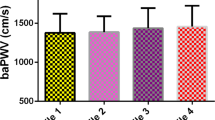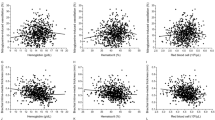Abstract
We investigated the relationship of serum uric acid (UA) with resting forearm blood flow (FBF), reactive hyperaemia (RH) and flow-mediated dilation (FMD) of the brachial artery in hypertensive adults (n=506, mean age 62 years, 59% women). UA was measured by a colorimetric method. FBF, RH and FMD were measured by brachial artery ultrasound. Regression analyses were used to assess whether UA was associated with FBF, RH and FMD before and after adjustment for age, sex, systolic BP, diabetes, total and high-density lipoprotein cholesterol, smoking, body mass index (BMI), C-reactive protein (CRP), serum creatinine, alcohol intake, statin and diuretic use and brachial artery diameter (BAD). UA was significantly associated with FBF (P<0.0001) and RH (P=0.0001) but not with FMD (P=0.43). After adjustment for the covariates listed above, higher UA level remained independently associated with a higher FBF (P=0.012) and lower RH (P=0.004). The independent predictors were as follows: (a) higher FBF: lower age, higher BMI, history of smoking, statin use, higher CRP, higher BAD and higher UA levels; (b) lower RH: higher BMI, diabetes and higher UA levels; (c) lower FMD: greater age, male sex, higher BMI, history of smoking, statin use and higher BAD. We conclude that in hypertensive individuals, higher UA levels are associated with higher resting FBF and lower RH, markers of microvascular function, but not with brachial artery FMD.
This is a preview of subscription content, access via your institution
Access options
Subscribe to this journal
Receive 12 digital issues and online access to articles
$119.00 per year
only $9.92 per issue
Buy this article
- Purchase on Springer Link
- Instant access to full article PDF
Prices may be subject to local taxes which are calculated during checkout

Similar content being viewed by others
References
Fam AG . Gout: excess calories, purines, and alcohol intake and beyond. Response to a urate-lowering diet. J Rheumatol 2005; 32: 773–777.
Viazzi F, Parodi D, Leoncini G, Parodi A, Falqui V, Ratto E et al. Serum uric acid and target organ damage in primary hypertension. Hypertension 2005; 45: 991–996.
Moens AL, Goovaerts I, Claeys MJ, Vrints CJ . Flow-mediated vasodilation: a diagnostic instrument, or an experimental tool? Chest 2005; 127: 2254–2263.
Nabel EG, Selwyn AP, Ganz P . Large coronary arteries in humans are responsive to changing blood flow: an endothelium-dependent mechanism that fails in patients with atherosclerosis. J Am Coll Cardiol 1990; 16: 349–356.
Vita JA, Keaney Jr JF, Larson MG, Keyes MJ, Massaro JM, Lipinska I et al. Brachial artery vasodilator function and systemic inflammation in the Framingham Offspring Study. Circulation 2004; 110: 3604–3609.
Corretti MC, Anderson TJ, Benjamin EJ, Celermajer D, Charbonneau F, Creager MA et al. Guidelines for the ultrasound assessment of endothelial-dependent flow-mediated vasodilation of the brachial artery. A report of the International Brachial Artery Reactivity Task Force. J Am Coll Cardiol 2002; 39: 257–265.
Hayoz D, Weber R, Rutschmann B, Darioli R, Burnier M, Waeber B et al. Postischemic blood flow response in hypercholesterolemic patients. Hypertension 1995; 26: 497–502.
Raison JH, Safar ME, London GM . Influence of sex and body weight on forearm hemodynamics in patients with sustained essential hypertension. Am J Hypertens 1991; 4: 820–826.
Raison JM, Safar ME, Cambien FA, London GM . Forearm haemodynamics in obese normotensive and hypertensive subjects. J Hypertens 1988; 6: 299–303.
Keevil BG, Nicholls SP, Kilpatrick ES . Evaluation of a latex-enhanced immunoturbidimetric assay for measuring low concentrations of C-reactive protein. Ann Clin Biochem 1998; 35: 671–673.
Malik AR, Sultan S, Turner ST, Kullo IJ . Urinary albumin excretion is associated with impaired flow- and nitroglycerin-mediated brachial artery dilatation in hypertensive adults. J Hum Hypertens 2007; 21: 231–238.
Kullo IJ, Malik AR, Bielak LF, Sheedy II PF, Turner ST, Peyser PA . Brachial artery diameter and vasodilator response to nitroglycerin but not flow-mediated dilatation are associated with presence and quantity of coronary artery calcium in asymptomatic adults. Clin Sci (London) 2006; 112: 175–182.
Mitchell GF, Parise H, Vita JA, Larson MG, Warner E, Keaney Jr JF et al. Local shear stress and brachial artery flow-mediated dilation: the Framingham Heart Study. Hypertension 2004; 44: 134–139.
Erdogan D, Gullu H, Caliskan M, Yildirim I, Ulus T, Bilgi M et al. Coronary flow reserve and coronary microvascular functions are strongly related to serum uric acid concentrations in healthy adults. Coron Artery Dis 2006; 17: 7–14.
Dakak N, Husain S, Mulcahy D, Andrews NP, Panza JA, Waclawiw M et al. Contribution of nitric oxide to reactive hyperemia: impact of endothelial dysfunction. Hypertension 1998; 32: 9–15.
Zoccali C, Maio R, Mallamaci F, Sesti G, Perticone F . Uric acid and endothelial dysfunction in essential hypertension. J Am Soc Nephrol 2006; 17: 1466–1471.
Anker SD, Leyva F, Poole-Wilson PA, Kox WJ, Stevenson JC, Coats AJ . Relation between serum uric acid and lower limb blood flow in patients with chronic heart failure. Heart 1997; 78: 39–43.
Kato M, Hisatome I, Tomikura Y, Kotani K, Kinugawa T, Ogino K et al. Status of endothelial dependent vasodilation in patients with hyperuricemia. Am J Cardiol 2005; 96: 1576–1578.
Maxwell AJ, Bruinsma KA . Uric acid is closely linked to vascular nitric oxide activity. Evidence for mechanism of association with cardiovascular disease. J Am Coll Cardiol 2001; 38: 1850–1858.
Mercuro G, Vitale C, Cerquetani E, Zoncu S, Deidda M, Fini M et al. Effect of hyperuricemia upon endothelial function in patients at increased cardiovascular risk. Am J Cardiol 2004; 94: 932–935.
Sanchez-Lozada LG, Nakagawa T, Kang DH, Feig DI, Franco M, Johnson RJ et al. Hormonal and cytokine effects of uric acid. Curr Opin Nephrol Hypertens 2006; 15: 30–33.
Kang DH, Park SK, Lee IK, Johnson RJ . Uric acid-induced C-reactive protein expression: implication on cell proliferation and nitric oxide production of human vascular cells. J Am Soc Nephrol 2005; 16: 3553–3562.
Nieto FJ, Iribarren C, Gross MD, Comstock GW, Cutler RG . Uric acid and serum antioxidant capacity: a reaction to atherosclerosis? Atherosclerosis 2000; 148: 131–139.
Gerlach E, Nees S, Becker BF . The vascular endothelium: a survey of some newly evolving biochemical and physiological features. Basic Res Cardiol 1985; 80: 459–474.
Des Rosiers C, Nees S, Gerlach E . Purine metabolism in cultured aortic and coronary endothelial cells. Biochem Cell Biol 1989; 67: 8–15.
Kayyali US, Donaldson C, Huang H, Abdelnour R, Hassoun PM . Phosphorylation of xanthine dehydrogenase/oxidase in hypoxia. J Biol Chem 2001; 276: 14359–14365.
Flynn Jr WJ, Pilati D, Hoover EL . Xanthine oxidase inhibition prevents mesenteric blood flow deficits after resuscitated hemorrhagic shock by preserving endothelial function. J Surg Res 1997; 68: 175–180.
Baldus S, Koster R, Chumley P, Heitzer T, Rudolph V, Ostad MA et al. Oxypurinol improves coronary and peripheral endothelial function in patients with coronary artery disease. Free Radic Biol Med 2005; 39: 1184–1190.
George J, Carr E, Davies J, Belch JJ, Struthers A . High-dose allopurinol improves endothelial function by profoundly reducing vascular oxidative stress and not by lowering uric acid. Circulation 2006; 114: 2508–2516.
Nagahama K, Inoue T, Iseki K, Touma T, Kinjo K, Ohya Y et al. Hyperuricemia as a predictor of hypertension in a screened cohort in Okinawa, Japan. Hypertens Res – Clin Exp 2004; 27: 835–841.
Armstrong KA, Johnson DW, Campbell SB, Isbel NM, Hawley CM . Does uric acid have a pathogenetic role in graft dysfunction and hypertension in renal transplant recipients? Transplantation 2005; 80: 1565–1571.
Sundstrom J, Sullivan L, D'Agostino RB, Levy D, Kannel WB, Vasan RS . Relations of serum uric acid to longitudinal blood pressure tracking and hypertension incidence. Hypertension 2005; 45: 28–33.
Levy BI . The importance of microcirculation and tissue perfusion in hypertension. Curr Med Res Opin 2005; 21 (Suppl 5): S1–S6.
Acknowledgements
This work was supported by: Grants HL81331 and M01 RR00585 from The National Institute of Health.
Author information
Authors and Affiliations
Corresponding author
Rights and permissions
About this article
Cite this article
de A Coutinho, T., Turner, S. & Kullo, I. Serum uric acid is associated with microvascular function in hypertensive individuals. J Hum Hypertens 21, 610–615 (2007). https://doi.org/10.1038/sj.jhh.1002193
Received:
Revised:
Accepted:
Published:
Issue Date:
DOI: https://doi.org/10.1038/sj.jhh.1002193
Keywords
This article is cited by
-
Association between bilirubin and cardiovascular disease risk factors: using Mendelian randomization to assess causal inference
BMC Cardiovascular Disorders (2012)
-
Serum uric acid is independently associated with hypertension in patients with rheumatoid arthritis
Journal of Human Hypertension (2008)
-
Serum uric acid, the endothelium and hypertension: an association revisited
Journal of Human Hypertension (2007)



